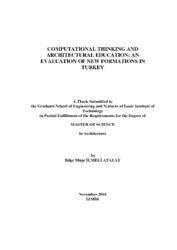Please use this identifier to cite or link to this item:
https://hdl.handle.net/11147/5706| Title: | Computational Thinking and Architectural Education: an Evaluation of Vew Formations in Turkey | Other Titles: | Hesaplamalı Düşünce ve Mimarlık Eğitimi: Türkiye'deki Yeni Formasyonların Bir Değerlendirilmesi | Authors: | İçmeli Atalay, Bilge Müge | Advisors: | İnceköse, Ülkü | Keywords: | Architectural design Computer aided design Architectural design education Computational thought Digital design |
Publisher: | Izmir Institute of Technology | Source: | İçmeli Atalay, B. M. (2016). Computational thinking and architectural education: An evaluation of vew formations in Turkey. Unpublished master's thesis, İzmir Institute of Technology, İzmir, Turkey | Abstract: | A significantly positive change has been noticed in the conceptual frame of the digital design and its influence on the related studies since the mid 60’s. The influence is quite noticeable in various research areas based on design theory such as architecture, biology and mathematics, etc…The same influence is also detectable on some theoretical cognitive and computational approaches. Instead of being seen mere means of visual presentation, digital tools are redefined as actual design areas in which the design process is formed. As a result, a variety of concepts known as computational design, computer aided design and digital architecture have come into existence. As expected, this change brings about a kind of paradigm in architectural education. On the other hand, it influences the design knowledge and causes changes in the educational models used for the teaching of design. As a consequence, architectural education bears the responsibility of reflecting the potential of both conventional and digital design methods in the designing process. Accordingly, instead of being only used for creating visual effects as in their early days, in this process of forming an architectural concept, digital tools begin to be used as complementary elements in the basic design learning process. In short, when the architectural education system undergoes a change in order to support the digital methods, the digital platform is not perceived only as a means of visual presentation. It accommodates the entire process of conceptualizing, creating and presenting. Accordingly, this dissertation attempts to question the evolution in the formation of design theories together with its impact and reflections in the education, and this thesis also aims to reveal some evolving educational models in the field. It also underlines the possible future of this particular educational model, and how the potentials of these models will be realized and perceived in their attempts to live up to future expectations. 60’lı yılların ortalarından itibaren dijital tasarım teorisi’nin kavramsal çerçevesinde ve etki alanında önemli bir gelişim görülmektedir. Tasarım teorisini esas alan pek çok araştırma alanında (mimarlık, biyoloji, matematik, vb…) kuramsal, bilişsel ve hesaplamalı yaklaşımların üstünde pek çok etkisi görülmüştür. Dijital araçlar, sadece görsel bir sunum amaçlı kullanımdan çıkıp tasarım sürecinin kendisini oluşturur tasarım ortamları haline gelmiştir. Böylece, Hesaplamalı Tasarım, Bilgisayar Destekli Tasarım, Dijital Mimari gibi farklı şekillerde tanımlanan oluşumlar ortaya çıkmaktadır. Bu değişim mimarlık eğitiminde doğal olarak bir paradigma yaratmakta, tasarım bilgisini etkilemekte ve tasarım bilgisinin verildiği eğitim modellerini değişmesine neden olmaktadır. Bu nedenle mimarlık eğitimi, hem dijital hem de geleneksel tasarım metodlarının tasarım sürecindeki potansiyelini göstermek yükümlülüğü içine girmiştir. Bu bağlamda kullanılmaya başlandığı ilk dönemlerde olduğu biçimi ile dijital araçlar sadece görsel sunum için kullanılmak veya form oluşturmak gibi görevler için kullanılmak yerine, mimari düşünceyi oluşturma sürecinde temel tasarım bilgisi öğrenim sürecini de kapsayacak biçimde kullanılır olmuştur. Sonuç olarak mimarlık eğitim sistemi, dijital metotlarda potansiyel sağlamak için değiştiğinde dijital ortam sadece görsel sunum aracı olarak kullanımdan çıkmaktadır. Tüm konsept sürecini, oluşturma ve sunum süreçlerini kapsamaktadır. Tez bu bağlamda, tasarım düşüncesi üretimindeki bu değişimin eğitimdeki karşılığını sorgular ve değişen eğitim modellerini açığa çıkarmayı hedefler. Bu eğitim modelinin nasıl olacağını ve gelecekteki beklentiler için bu modellerin potansiyellerini nasıl kavrayacaklarını açığa çıkarır. |
Description: | Thesis (Master)--İzmir Institute of Technology, Architecture, İzmir, 2016 Includes bibliographical references (leaves. 69-73) Text in English; Abstract: Turkish and English ix, 73 leaves |
URI: | http://hdl.handle.net/11147/5706 |
| Appears in Collections: | Master Degree / Yüksek Lisans Tezleri |
Files in This Item:
| File | Description | Size | Format | |
|---|---|---|---|---|
| T001543.pdf | MasterThesis | 3.74 MB | Adobe PDF |  View/Open |
CORE Recommender
Page view(s)
278
checked on Apr 21, 2025
Download(s)
254
checked on Apr 21, 2025
Google ScholarTM
Check
Items in GCRIS Repository are protected by copyright, with all rights reserved, unless otherwise indicated.